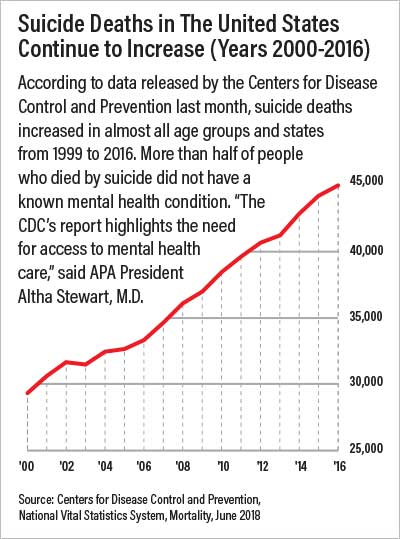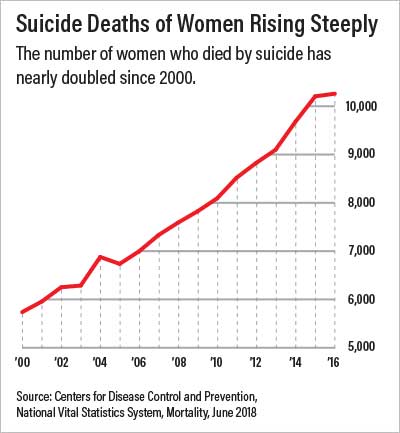Suicide Deaths Climb Dramatically in U.S., Nearly Double for Women
Abstract
Experts say that the increase in suicides is related to a combination of factors, including undiagnosed mental illness.
Suicide rates in the United States have risen 30 percent over the past decade and a half, according to data from the Centers for Disease Control and Prevention (CDC). The findings, which were released last month in two reports, coincided with the suicides of celebrities Kate Spade and Anthony Bourdain.

“One of the issues that we are grappling with in this country and in many places all over the world is that not everyone who needs attention gets attention—or even knows that he or she needs psychiatric care,” said suicide expert Maria A. Oquendo, M.D., Ph.D., past president of APA and professor and chair of the Department of Psychiatry at the Perelman School of Medicine at the University of Pennsylvania. She is also chair of the Board of Scientific Directors of the American Foundation for Suicide Prevention.
The reports, released on June 7 and June 14, examined state and national suicide trends, respectively.
Holly Hedegaard, M.D., and colleagues from the CDC’s National Center for Health Statistics published the June 14 report indicating that roughly 45,000 Americans died by suicide in 2016. That same year, suicide became the second leading cause of death among those aged 10 to 34 and the fourth leading cause among those aged 35 to 54, according to the report. (Since 2008, suicide has ranked as the 10th leading cause of death for all age groups in the United States.)
The researchers found that from 2000 to 2016, the age-adjusted suicide rate increased from 10.4 per 100,000 people to 13.5 per 100,000 people in the United States. From 2000 through 2006, the suicide rate increased by about 1 percent a year and by an average of 2 percent a year from 2006 through 2016. In the 16-year timeframe, the suicide rate increased by 21 percent for men and by 50 percent for women.
Oquendo noted that in 2016 about 50 percent of these deaths involved the use of a firearm. Firearms were the most common method of suicide for men 15 and older and the second most common for women aged 45 and older, according to the report.
“Firearms are especially dangerous because the likelihood of lethality is very high. A person who is prone to suicidal ideas or behavior should not have easy access to them.”
She advised anyone living with a person who is suicidal to remove guns from the home, and, if that isn’t possible, to make sure guns are locked away and not loaded.
What’s Driving the Dramatic Increase?
“Suicide is rarely caused by any single factor, but rather it is determined by multiple factors,” Deborah Stone, Sc.D., and colleagues from the CDC wrote in the June 7 report. Such factors include mental illness and prior suicide attempts, social and economic problems, access to lethal means, and poor coping and problem-solving skills, the authors wrote. “Examining state-level trends in suicide and the multiple circumstances contributing to it can inform comprehensive state suicide prevention planning.”
Relying on data from the CDC’s National Vital Statistics System, Stone and colleagues calculated national- and state-level suicide rate estimates for people aged 10 and older from 1999 to 2016. Suicide rates increased in all states except Nevada, where the rate nonetheless remained consistently high (above 21 per 100,000 people) throughout the study period; the absolute increases in suicide rates ranged from 0.8 per 100,000 people in Delaware to 8.1 per 100,000 people in Wyoming.

The researchers also compared the characteristics of people who died by suicide, with and without known mental health conditions, in the 27 states that had a complete dataset in the CDC’s National Violent Death Reporting System in 2015.
While most of the people who died by suicide were male (76.8 percent) and non-Hispanic white (83.6 percent), those without known mental health conditions were more likely to be male (83.6 percent versus 68.8 percent) and belong to a racial/ethnic minority than those with known mental health conditions.
“We know from other research that most people who die by suicide have mental health conditions, though they may not have been formally diagnosed or treated,” APA President Altha Stewart, M.D., said in a statement. “People should know that suicide is preventable. Anyone contemplating suicide should know that help is available and that there is no shame in seeking care for your mental health.”
Finding Points of Intervention
Stone and colleagues found that approximately half of those with known mental health conditions were in treatment at the time of their suicide.
“We [as clinicians] know that people go in and out of suicidal crises, and patients don’t always bring suicide up spontaneously,” Oquendo said.
“We need to be vigilant and ask patients about suicide on a regular basis. We also need to be very proactive about trying to prevent recurrent psychiatric episodes, whether it’s depressive episodes or psychotic episodes or episodes of substance abuse.”
Oquendo, who has used positron emission tomography and magnetic resonance imaging to map brain abnormalities in people with mood disorders and suicidal behavior, said it is important for researchers to examine the underlying biology of suicidal behavior.
This may lead to the development of more effective treatments for suicidal ideation involving psychotherapy as well as medication, she said.
“The CDC data on suicide reinforce the need to fund and enforce laws ensuring access to mental health services,” said APA CEO and Medical Director Saul Levin, M.D., M.P.A., in a statement. “Early identification of mental illness is essential, and we are ready to work with Congress and other stakeholders to ensure that Americans can receive treatment when needed.” ■



